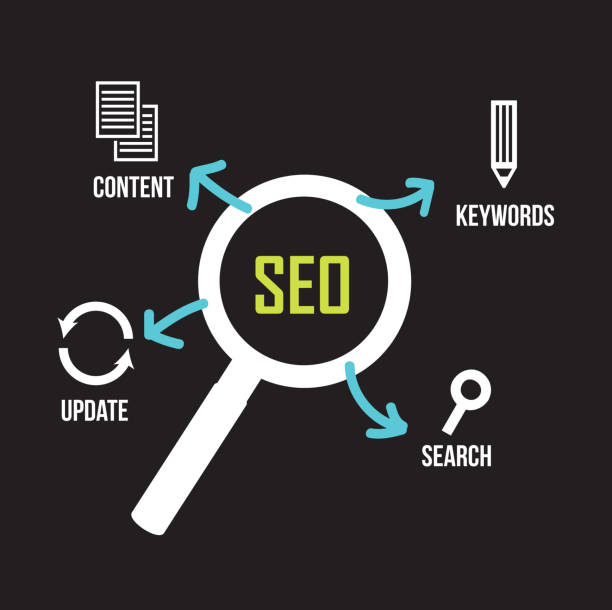Understanding the Basics of SEO and Its Importance

In today’s digital age, being seen amidst a deluge of information has become a major challenge.
This is where the concept of SEO (Search Engine Optimization) plays a vital role.
SEO is a process that optimizes your website to achieve higher rankings in organic search engine results, especially on Google.
The main goal is to increase high-quality traffic to the website through user searches.
Imagine your website is a shop in a big city; without SEO, your shop is located on a dark side street that no one finds.
But with SEO, this shop is moved to the main, busy street, exposed to thousands of potential customers.
This is an #educational and #explanatory process that helps you make your website more understandable and appealing to complex search engine algorithms.
SEO is not just about keyword placement; it encompasses a set of techniques and strategies, ranging from user behavior analysis to improving the technical structure of the website.
The importance of SEO is such that modern businesses, without paying attention to it, practically have little chance of survival and growth in the online space.
Users usually only trust the initial search results and ignore subsequent pages.
Therefore, if you want to be seen, you must be on the first page.
This continuous and dynamic optimization puts your website on the path to long-term success and brings you targeted, free traffic.
In fact, SEO is an investment in your digital future that yields significant returns.
Does your company’s website create a professional and lasting first impression in the minds of potential customers? Rasawab, with its professional corporate website design, not only reflects your brand’s credibility but also paves the way for your business growth.
✅ Build a powerful and reliable brand image
✅ Attract target customers and increase sales
⚡ Get free consultation
Types of SEO: On-Page, Off-Page, and Technical

To understand SEO more deeply, we must divide it into three main areas: On-Page SEO, Off-Page SEO, and Technical SEO.
Each of these sections plays an important role in improving your website’s ranking in search results and complements the others.
This categorization helps us to have a comprehensive and #specialized strategy for optimization.
On-Page SEO refers to all factors that you can directly control on your website and optimize for search engines.
This includes content optimization, correct use of keywords, optimizing titles (H1 to H6 tags), meta descriptions, images (with appropriate Alt Text), and URL structure.
The quality and relevance of content to keywords are the core of On-Page SEO.
Off-Page SEO refers to activities outside your website that influence its ranking.
The most important factor in Off-Page SEO is Link Building; that is, obtaining high-quality links from other reputable websites.
These links show search engines that your website is trustworthy and authoritative.
Activity on social networks and mentioning your brand on various platforms are also considered part of Off-Page SEO.
Finally, Technical SEO deals with optimizing the website’s infrastructure to improve Crawling and Indexing by search engines.
This includes site loading speed, mobile compatibility, use of HTTPS, Sitemap structure, robots.txt file, and 404 error management.
A website with strong Technical SEO provides a better user experience and allows search engines to correctly understand and rank your content.
All these sections together form a search engine optimization strategy that is essential for success.
Keyword Research: The Backbone of SEO

Keyword research is the foundation of every successful SEO strategy.
Without a precise understanding of the words users employ to find your content, all optimization efforts will be in vain.
This process involves identifying words and phrases that your target audience types into search engines, and then analyzing their search volume, competition, and user intent.
Our goal is to find keywords with appropriate search volume and reasonable competition that are relevant to our business.
Tools like Google Keyword Planner, Ahrefs, and SEMrush can assist you at this stage.
These tools provide valuable data regarding search volume, competition level, and related keywords, which is extremely useful for an #analytical and #educational analysis.
Keywords can be broadly divided into two categories: Short-tail keywords, which usually have one to three words and are highly competitive, and Long-tail keywords, which have three or more words and are generally more specific and less competitive.
Long-tail keywords often indicate a specific purchase intent or a very specific information search, and they can bring highly targeted traffic to your website.
Furthermore, understanding the User Intent behind a keyword is crucial; is the user looking for information (Informational), intending to make a purchase (Commercial), or wishing to go to a specific website (Navigational)? Matching your content with user intent significantly increases your chances of achieving a high SEO ranking.
The table below shows an example of keyword analysis:
| Keyword | Monthly Search Volume | Competition (Keyword Difficulty) | User Intent |
|---|---|---|---|
| Best smartphone 2024 | 250,000 | High | Commercial/Informational |
| Buy iPhone 15 Pro Max in installments | 10,000 | Medium | Commercial |
| Technical specifications of iPhone 15 camera | 3,000 | Low | Informational |
This process helps you shape your content strategy based on what users are truly looking for, and increases your chances of achieving top rankings in search results.
Keyword research is the beating heart of SEO.
Producing Valuable and SEO-Optimized Content

Content is king; this phrase holds ever more importance in the world of SEO.
Producing valuable and high-quality content is the cornerstone of a successful SEO strategy.
Search engines aim to provide the best and most relevant answers to user queries, so your content must meet this need.
This does not mean writing long and aimless articles, but rather creating content that is accurate, comprehensive, and user-friendly.
Content that attracts users, answers their questions, and encourages them to take a specific action (like purchasing or signing up).
For this purpose, various types of content can be used, such as #educational articles, #explanatory guides, and even #thought-provoking content that prompts the audience to think and interact.
When creating content for SEO, you should pay attention to key points:
Firstly, naturally incorporate your target keywords into the text, headings (H1, H2, H3, etc.), and meta descriptions.
Avoid over-stuffing the text with keywords (Keyword Stuffing), as this can lead to penalties from search engines.
Secondly, your content structure should be clear and readable.
Using appropriate headings, short paragraphs, lists, and relevant images enhances readability and improves user experience.
Thirdly, don’t forget internal linking.
By linking to other relevant pages on your website, you help search engines better understand your website’s structure and distribute authority among pages.
Fourthly, keep your content unique and fresh.
Avoid copying content from other websites.
Search engines reward original content.
Finally, always strive to provide value beyond user expectations.
High-quality and engaging content is not only beneficial for SEO but also increases user engagement and converts them into loyal customers.
SEO is an ongoing process, and producing fresh, optimized content plays a significant role in maintaining and improving your ranking.
Did you know that 94% of users’ first impressions of a business are related to its website design? With professional corporate website design by **Rasawab**, turn this first impression into an opportunity for growth.
✅ Attract more customers and increase sales
✅ Build credibility and trust in the audience’s eyes⚡ Get free website design consultation!
Technical SEO: Website Infrastructure Optimization

Technical SEO deals with optimizing the technical aspects of your website so that search engines can easily crawl and index it.
Although this part of SEO might be less visible, it plays a vital role in your website’s overall SEO performance.
Without a strong technical infrastructure, even the best content may never reach its target audience.
This is a completely #specialized field that requires precise technical knowledge.
One of the most important aspects of technical SEO is site loading speed.
Users and search engines detest slow websites.
Google is increasingly emphasizing Core Web Vitals, which include metrics like Largest Contentful Paint (LCP), First Input Delay (FID), and Cumulative Layout Shift (CLS), directly impacting user experience (UX) and consequently SEO ranking.
Improving site speed can involve image optimization, file compression, using a CDN, and improving server response time.
Also, mobile compatibility is a key ranking factor, as Google uses a Mobile-First Indexing approach.
This means that the mobile version of your website is the primary version for Google to crawl and index.
Using HTTPS (website security) is also essential for SEO, as Google prefers secure websites.
Other aspects of technical SEO include optimizing URL structure, using Canonical Tags to prevent duplicate content, creating an XML Sitemap to help search engines find all your pages, and correctly using the robots.txt file to control crawler access to different parts of your website.
Structured Data (structured data) helps search engines better understand your content and display it as Rich Snippets in search results.
Neglecting technical SEO can undermine your content SEO and link-building efforts, so paying attention to these aspects is vital for a comprehensive SEO strategy.
Link Building and Increasing Domain Authority

Link Building is one of the main pillars of Off-Page SEO and refers to the process of acquiring links from other websites to your website.
These links, known as backlinks, act like a vote of confidence for search engines.
The more reputable and relevant websites link to you, the more your website’s Domain Authority and strength increase, leading to an improvement in your search results ranking.
The quality of links is far more important than their quantity; one link from a highly reputable and relevant website is worth significantly more than dozens of links from low-quality and irrelevant websites.
This section of SEO includes many #guidance and strategic tips.
- Creating excellent content: Superb content that naturally attracts links.
This is the #thought-provoking and #educational content that users want to share. - Guest Posting: Writing high-quality articles for other relevant websites and receiving a link back to your website.
- Broken Link Building: Finding broken links on other websites and suggesting your content as a replacement.
- Influencer Outreach: Collaborating with influential individuals and websites in your niche to promote content and gain links.
- Using reputable resources and directories: Registering your website in specialized and reputable directories.
The importance of Anchor Text should also not be overlooked.
Anchor text is the visible, clickable text in a hyperlink and should be descriptive and relevant to the destination page.
Using diverse and natural anchors, instead of repeatedly using a single keyword, is very important.
Link building is a time-consuming and ongoing process that requires a precise strategy and continuous execution to achieve desired SEO results.
Measuring and Analyzing SEO Performance

After implementing SEO strategies, the next crucial step is to measure and analyze their performance.
Without precise measurement, you cannot understand what is working and what needs improvement.
This stage allows you to make data-driven decisions and optimize your SEO strategy.
Tools like Google Analytics and Google Search Console are two primary and free resources for this purpose.
These tools provide comprehensive information about website traffic, keywords, page performance, and technical issues.
Data analysis gives you the necessary #analytical insight to understand how effective your SEO efforts have been.
Key metrics to monitor in SEO include:
- Organic Traffic: The number of visitors who come to your website through organic search results.
- Keyword Rankings: Your website’s position for specific keywords in search results.
- Bounce Rate: The percentage of visitors who leave the website after viewing one page.
A low bounce rate indicates relevant content and a good user experience. - Conversion Rate: The percentage of visitors who complete your desired action (e.g., purchase, newsletter signup).
- Top Pages: Which pages receive the most organic traffic.
Google Search Console provides information about how Google crawls your site, crawl errors, internal and external links, and the keywords that lead users to your top pages.
Google Analytics offers a more comprehensive view of user behavior on your website, including session duration, visitor paths, and traffic sources.
Using this information, you can identify the strengths and weaknesses of your SEO strategy and plan for their improvement.
This is a continuous #guidance and monitoring process vital for maintaining and enhancing your SEO position.
This analysis helps you make better decisions for search engine optimization.
| Metric | Description | Related Tool |
|---|---|---|
| Organic Traffic | Number of visitors from natural searches | Google Analytics, Google Search Console |
| Click-Through Rate (CTR) | Percentage of clicks on your link in search results | Google Search Console |
| Bounce Rate | Percentage of visitors who leave the site after viewing one page | Google Analytics |
| Page Speed | Website page loading speed | Google PageSpeed Insights, Lighthouse |
Local SEO and E-commerce SEO

SEO is not just for large or general websites; it can be highly specialized to meet the specific needs of businesses.
Two important and growing areas in this field are Local SEO and E-commerce SEO.
Local SEO is crucial for businesses that serve customers in a specific geographical area.
Such as restaurants, shops, salons, or doctors.
The goal of local SEO is to help these businesses appear in search results when users are looking for services or products near them.
The most important tool for local SEO is Google My Business (GMB).
By creating and optimizing your GMB profile, you can display contact information, business hours, address, and customer reviews.
Receiving positive customer reviews, using local keywords on your website, and building Local Citations in directories are other important factors in local SEO.
E-commerce SEO is the optimization of online store websites where products are sold online.
This type of SEO has its own complexities and requires a deep understanding of how users search for products.
Optimizing product pages and category pages is highly important.
This includes using unique and comprehensive product descriptions, optimizing product images, using Schema Markup (structured product data) to display prices, availability, and reviews in search results, as well as managing user reviews.
The navigation and architecture of the e-commerce site should be easy for both users and search engine crawlers.
Site speed is crucial for online stores, as loading delays can lead to customer loss.
Due to the high volume of competition and product variety, E-commerce SEO is a highly competitive and specialized area of SEO that requires continuous attention to detail.
Improving SEO in these areas can directly lead to increased sales and revenue.
Are you dissatisfied with the low conversion rate of visitors to customers on your e-commerce site?
Solve this problem permanently with professional e-commerce website design by Rasawab!
✅ Increase visitor-to-customer conversion rate
✅ Create an excellent user experience and build customer trust
⚡ Get free consultation
The Future of SEO: AI and Voice Search

The world of SEO is never static and is constantly evolving.
Search engine algorithms, especially Google’s, are updated at a rapid pace, and understanding these changes is essential for SEO success.
The most important future trends in SEO include the increasing role of Artificial Intelligence and the growth of voice search.
Artificial intelligence (AI), with algorithms like BERT and MUM, is changing how Google understands and processes search queries.
These algorithms can better understand user intent, even if precise keywords haven’t been used.
This means that SEO professionals must focus on providing high-quality, comprehensive content that addresses users’ actual needs, rather than just keyword stuffing.
These developments require a #news and #analytical approach to keep pace with changes.
Voice Search is another important future trend in SEO.
With the proliferation of voice assistants like Siri, Google Assistant, and Alexa, the number of users searching by voice is increasing.
Voice searches are typically longer, more conversational, and resemble full questions (e.g., “Where is the best Italian restaurant near me?” instead of “Italian restaurant Tehran”).
To optimize for voice search, you should focus on long-tail keywords, frequently asked questions (FAQs), and providing direct, concise answers.
Additionally, Structured Data (Structured Data) can help search engines optimize your content for voice search responses.
Video SEO also gains more importance with the increasing consumption of video content.
Optimizing video titles, descriptions, tags, and transcripts can help them appear in video search results and even in main search results.
Ultimately, the future of SEO is moving towards focusing on user experience, a deeper understanding of user intent, and providing valuable and responsive content for all types of searches, including voice and video.
This requires an #analytical approach and readiness for continuous changes.
Common SEO Mistakes and Best Practices

On the winding path of SEO, many mistakes can occur that might render your efforts fruitless or even harm your website’s ranking.
Understanding these common mistakes and adhering to best practices is essential for sustainable SEO success.
This section is a #guidance and entertaining guide (because learning from others’ mistakes can be instructive and sometimes amusing) to avoid pitfalls.
One of the biggest mistakes is Keyword Stuffing; that is, the excessive and unnatural use of keywords in text in hopes of improving ranking.
This practice not only leads to penalties from search engines but also severely degrades the user experience.
Instead, focus on producing high-quality, natural content where keywords are organically integrated.
Another mistake is neglecting technical SEO.
Slow site speed, lack of mobile compatibility, and poor website architecture can prevent your content from being correctly crawled and indexed by search engines.
Always use tools like Google PageSpeed Insights to check speed and Mobile-Friendly Test to verify mobile compatibility.
Duplicate Content is also a common problem that can harm your ranking; ensure that every page on your website has unique content.
Furthermore, neglecting quality link building and focusing solely on link quantity can hurt your SEO instead of improving it.
Avoid irrelevant and spammy links.
Finally, failure to update content and SEO strategy is another common mistake.
SEO is not a static process; algorithms change, and competitors are constantly striving for improvement.
Therefore, regularly update your content, continue SEO analyses, and adapt your strategy to the latest changes.
By avoiding these mistakes and following the best practices mentioned in previous sections, you can create a strong and sustainable SEO strategy that helps your website grow long-term in search results.
Focusing on the user and providing value is always the key to SEO success and influences all search engine optimization efforts.
Frequently Asked Questions
| Question | Answer |
|---|---|
| What is SEO? | SEO, or Search Engine Optimization, is the process of increasing the quality and quantity of website traffic by improving the site’s ranking in natural (organic) search engine results like Google. |
| What are the main types of SEO? | SEO is divided into three main categories: On-Page SEO, Off-Page SEO, and Technical SEO. |
| What does On-Page SEO include? | On-Page SEO includes optimizing elements within the website, such as keywords, title tags, meta descriptions, content, URL structure, images, and internal links. |
| What is Off-Page SEO? | Off-Page SEO refers to activities outside the website that help improve its ranking, such as backlink building, social media marketing, and brand mentions. |
| What is Technical SEO? | Technical SEO focuses on optimizing the technical aspects of a website to help it be better crawled and indexed by search engines. This includes site speed, mobile-friendliness, site structure, sitemaps, and the Robots.txt file. |
| What role do Keywords play in SEO? | Keywords are phrases that users enter into search engines. Proper and targeted use of relevant keywords in content and site elements helps search engines understand your page’s topic and display it for relevant searches. |
| What is a Backlink and why is it important? | A backlink, or inbound link, is a link from one website to another. Backlinks act as a “vote of confidence” from other sites for search engines and play a crucial role in the authority and ranking improvement of a site, especially if they are from reputable sites. |
| What is the impact of quality content on SEO? | Quality content that is relevant, comprehensive, and unique not only attracts and retains users but also signals to search engines that your page is valuable. This helps improve ranking, reduce bounce rate, and increase user time on site. |
| Why is site loading speed important for SEO? | Site loading speed is an important ranking factor for Google. Faster sites offer a better user experience, have lower bounce rates, and are preferred by search engines. |
| Is SEO a one-time process? | No, SEO is an ongoing and long-term process. Search engine algorithms are constantly changing, competition is increasing, and site content also needs updating. Therefore, SEO requires continuous monitoring, analysis, and optimization. |
And other services of Rasa Web Advertising Agency in the field of advertising
Smart UI/UX: A combination of creativity and technology to improve SEO ranking through custom programming.
Smart Advertorials: A combination of creativity and technology to increase site traffic through intelligent data analysis.
Smart Digital Branding: A professional solution for analyzing customer behavior with a focus on SEO-driven content strategy.
Smart Direct Marketing: Designed for businesses seeking digital branding through custom programming.
Smart Conversion Rate Optimization: An effective tool for digital branding with the help of custom programming.
And over hundreds of other services in the field of internet advertising, advertising consultation, and organizational solutions
Internet Advertising | Advertising Strategy | Advertorials
Resources
SEO Guide on VirgolComprehensive SEO Tutorial on RankupWhat is SEO? – SeokarThe Importance of SEO in Digital Marketing (Digiato)
❓ To reach the pinnacle of success in the digital world, Rasawab Afarin, by providing comprehensive digital marketing services including website design with a modern user interface, paves the way for your business.
📍 Tehran, Mirdamad Street, next to Bank Markazi, Southern Kazeroon Alley, Ramin Alley, No. 6




